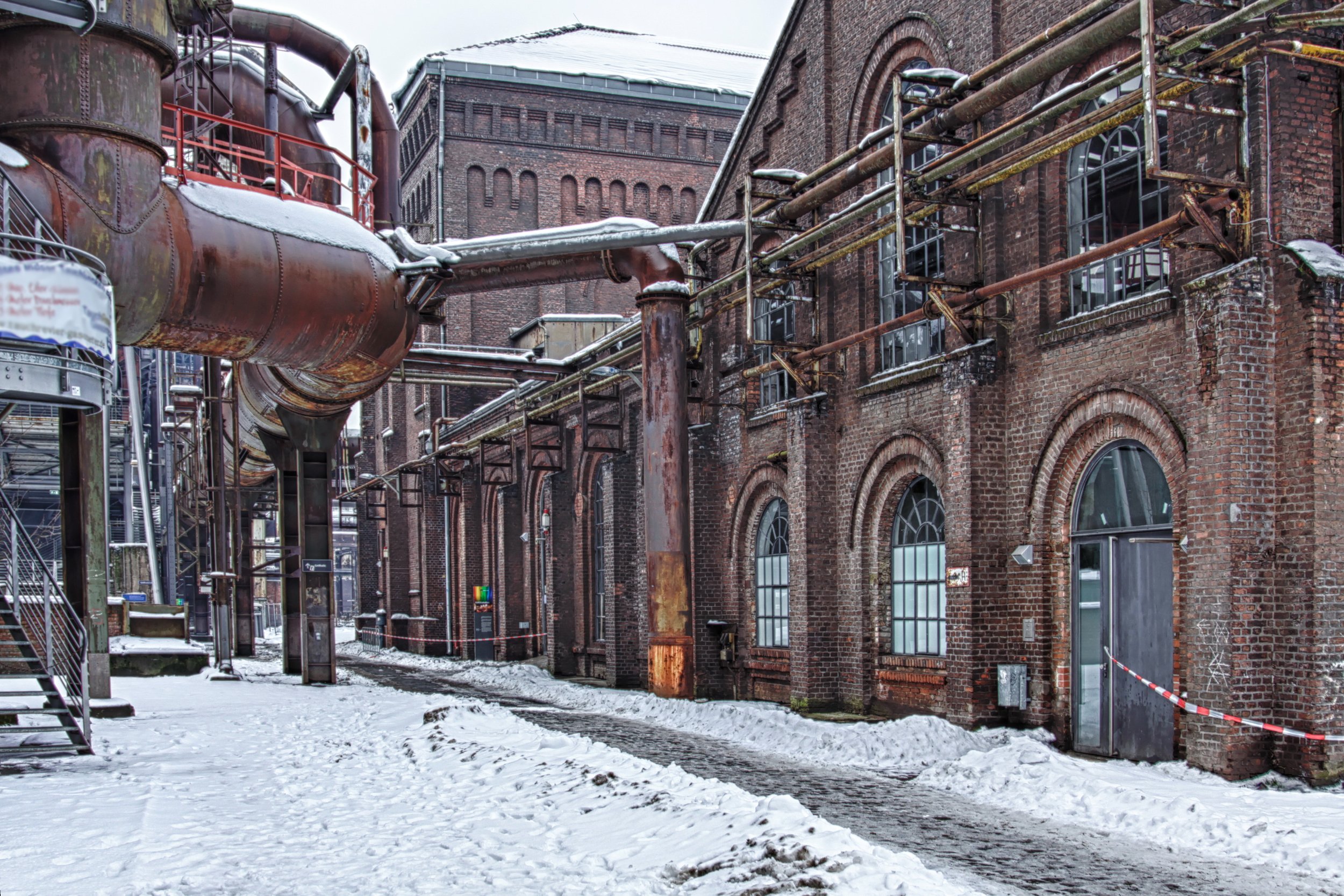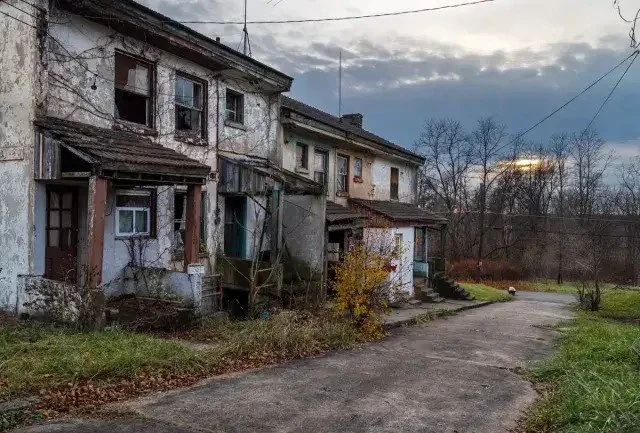
Mahoning Valley Steel and the Emergence of Modular Living
School: Harvard GSD | Course: Theories of Landscape as Urbanism | Semester: Fall 2024
Youngstown Sheet and Tube Company was once a global leader in steel production, renowned for its influence and innovation. Headquartered in the Mahoning Valley, the company employed over 30,000 workers (1) across the Midwest and contributed a significant share to the nations steel production. In 1916, amid growing tensions over poor living conditions and low wages, steelworkers rioted, highlighting the urgent need for improvements. That same year, Sheet and Tube planned for three company housing developments to support its diverse workforce and their families.
The resulting “Workingmen’s Colony” in Campbell, Ohio, built for immigrant and African American workers, gained international acclaim for its use of prefabricated materials and pioneering construction methodology. Today, the Campbell Colony still stands, but as an ageing National Monument. While the durable concrete units have withstood time, visitors experience only a shell of what was once considered the future of housing.
Photo: The Mahoning Valley, located in Northeast Ohio. Credit: Quilian Riano.
Steel Valley
Nestled in northeastern Ohio a modest and unassuming region once rose to global prominence as the largest steel-producing hub in the world. Known as the Mahoning Valley, and famously nicknamed “Steel Valley,” it became a steelmaking powerhouse by the early twentieth century thanks to its favorable position between iron ore-rich Lake Erie and the abundant coal mines of West Virginia. However, it was the block coal found in Youngstown that was the major catalyst for the establishment of the iron industry in the Valley. “The nation’s westward expansion increased demand for iron, guaranteeing that the Mahoning Valley’s iron furnaces would stay busy. By the 1850s, the valley was one of the nation’s leading centers of iron production.” (2) As American industrialization continued, the Mahoning Valley gradually shifted its efforts toward steel production, consolidating iron production into enormous steel mills that offered end-to-end steelmaking capabilities. The rise of steel production in the Valley helped shape its economy and fueled its urbanization, while contributing to industrialization on a global scale. Among the most prominent mills were Youngstown Sheet and Tube Company.
By the twentieth century, Youngstown Sheet and Tube, among other steel mills, had drawn thousands of European immigrants to the Mahoning Valley seeking economic opportunities to support their families. “It was estimated, four out of five residents were immigrants or first-generation Americans” (3) However, with the growth of steel production came unforeseen challenges for its unskilled workers. “WWI resulted in increased production in Ohio’s steel mills by late 1915, and unskilled steelworkers – who were often working grueling 12-hour shifts, 6 days a week – were struggling to live on meager wages.”(4)
Steelworker Strike of 1916
By 1916, the Mahoning Valley steelworkers’ tempers flared as they officially went on strike. The strike led to intense confrontation with mill guards, resulting in deaths of three individuals. In retaliation, the strikers proceeded to vandalize nearly 100 blocks of businesses and residences in the Valley. Just as the National Guard was called in to calm the rioters, managers of the steel companies agreed to increase wages, resulting in an end to the strike. (4)
Photo: The aftermath of the steelworker strike. 1916. Credit: Hidden History of Youngstown and the Mahoning Valley
Segregated Company Housing
In response to the riots, Youngstown Sheet and Tube proposed housing developments to improve living conditions for its workers. Called “Workingmen’s Colonies,” three housing subdivisions were planned in the Valley. The colony located in Campbell, just across the Mahoning River from Sheet and Tube, was to house the immigrant and African American workers. Although the development offered modern amenities like indoor plumbing and electricity, a broader intention was clear in the design, to control the foreign-born and African American workforce by integrating them deeper into Youngstown Sheet and Tube Company as both employee and renter to establish more control. “The architects “naturally segregated” the African American section of the development by creating a separate entrance and central square for it, and by moving the homes’ front porches to the back, thus reducing the visibility of residents from the street and making this section of the neighborhood feel and appear more ‘contained.’ (4)
Despite the discriminatory nature, the development was a success in the eyes of its residents. Designed by St. Louis-based architecture and planning firm Conzelman, Herding and Boyd, the inward design of the development offered residents private gardens, playgrounds, and porches that promoted a sense of community. “The success of the Youngstown project resulted from the efficient use of materials, ease of construction, and the hillside site plan that created a handsome neighborhood of semi-detached houses with gardens, landscaping, and public and private outdoor spaces.” (5)
Photo: Children of Campbell Colony housing gathering at the archway on Robinson Road. 1920. Credit: National Archives Catalog.
Groundbreaking Innovation
After the endorsement by residents, the architecture world took notice of the development’s innovative construction techniques. “The resulting company housing is an early example of using concrete as a building material for a large-scale residential project, and this innovation is reflected in the extensive coverage its construction received in Engineering News-Record” (6) The development was constructed using the “unit method,” with walls and floors erected from large, precast concrete slabs. “This type of construction was patented by the contractors, the Unit Construction Company, and had been used extensively in the railway field for small bridges, railings, trainsheds, and also for warehouse roofs and elevators.”
The technology was first used in the experimental housing development at Forest Hills Gardens in Queens, New York. Though appearing successful on the surface, Forest Hills was not the ‘affordable housing’ venture it sought out to be. There were issues with the transporting and erecting of concrete slabs that made Forest Hills Gardens a project not worth duplicating. (7) In contrast, the Workingmen’s Colony at Campbell, constructed with efficiency and low-cost materials, was highly successful. The use of the nearby hillside for gravity-feed production and the creation of a patented 360-degree crane added to the significance this project had in construction methodology. (6) “The Youngstown project was widely regarded by many at the time as an example of future building practices. The project architects and landscape architects presented the project at the 1920 National Meeting of the American Institute of Architects.” (6)
Photo: Erection of prefabricated concrete slabs at Campbell’s Working Colony. 1918. Credit: The Architectural League New York.
A Landmark Nearly Lost
Today, the dilapidated Colony at Campbell endures as a registered National Monument, a testament to the innovative construction methods and craftsmanship of its era. Yet, a visit to the Mahoning Valley reveals a stark contrast to the thriving steel community it once was. As the region battles economic challenges after mill closures, a question arises – will it resurge as a new symbol of American prosperity, or will it forever be known as the Steel Valley? One thing is certain: the Workingmen’s Colony at Campbell will always be remembered as one of the most groundbreaking and historically significant projects of its kind, a legacy that will forever belong to the Mahoning Valley.
Photo: The Campbell Colony weathers in place. 2018. Credit: Johnny Joo.
References
1. Joo, Johnny. “Youngstown Sheet & Tube: The First Concrete Pre-Fab Estate in the World - Architectural Afterlife.” Architectural Afterlife - Preserving History Of Abandoned And Historic Places (blog), February 6, 2019. https://architecturalafterlife.com/2018/06/youngstown-sheet-tube-the-first-concrete-pre-fab-estate-in-the-world/.
2. Ohio History Connection. “Youngstown Historical Center of Industry & Labor - Ohio History Connection,” December 14, 2023. https://www.ohiohistory.org/visit/browse-historical-sites/youngstown-historical-center-of-industry-labor/.
3. Guerrieri, Vince. “What Happened to Youngstown? - Pittsburgh Quarterly.” Pittsburgh Quarterly, September 19, 2022. https://pittsburghquarterly.com/articles/what-happened-to-youngstown/.
4. Herstad, Kaeleigh. “‘The Workingmen’s Colony’: Labor Conflict and Historic Preservation in Campbell, Ohio.” Rustbelt Anthro, December 3, 2018. https://rustbeltanthro.wordpress.com/2018/10/08/the-workingmens-colony-labor-conflict-and-historic-preservation-in-campbell-ohio/.
5. Rogers, Rebecca. “Youngstown Sheet and Tube Company Housing.” SAH ARCHIPEDIA, September 24, 2019. https://sah-archipedia.org/buildings/OH-01-099-0064.
6. Schodek, Daniel L. "Precast Concrete Housing: The Youngstown Project." Journal of Prestressed Concrete Institute23, (November–December 1978), 54-64.
7. Jara, Cynthia, “Prefabrication in the Design of Housing at Forest Hills Gardens in New York, 1909-19.: University of Minnesota, 287.





